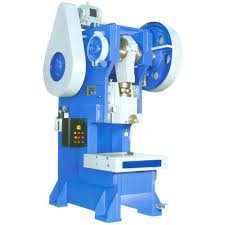
This broad category of machines includes equipment for making metal parts via the following operations: blanking, forging, flanging, shearing, bending, drawing, squeezing, coining, forming, hammering, and upsetting. Most modern press machine typically combine electric motors and hydraulics to provide the required pressure. The dies used in presses also changed as presses did, and vice versa.
It usually consists of a straightforward rectangular frame, frequently made of C-channel or tubing, that houses a hydraulic cylinder or bottle jack to apply pressure to a workpiece via a ram. It is frequently used for everyday shaping work in garages, machine shops, basement shops, car repair shops, etc.
Depending on size and structure, standard shop presses have a pressure range of 1 to 30 tonnes. Arbor presses are a common name for lighter-duty variations. To press interference-fit components together, such as gears onto shafts or bearings into housings, a shop press is frequently employed.
Classification:
- Presses can be categorized based on their:
- Power source: such as manually operated or power press machines,
- mechanism: such as mechanical, hydrolytic, pneumatic,
- structure: such as a Knuckle-joint press or a screw press,
- function: press brakes, forging presses, punch presses, and stamping presses,
- controllability such as ordinary presses and servo-presses.
Safety:
Safety precautions must always be followed since these machines can be dangerous. Light sensors that stop the machine from operating if the user is within range of the die and bi-manual controls, which require both hands always to be kept on the buttons to function, are also excellent ways to prevent mishaps.
Classification according to Power Source:
Manually Operated Press Machines:
These units are the most straightforward press machine, requiring manual press operation. This type of machine is employed when working with thin metal sheets, where less force and pressure are needed. It is manually operated. Small operations like piercing, blanking, bending, etc., are performed with these presses. Ball presses, hand presses, and fly presses are manual press machinery.
The frame, handle, ram, iron ball, nut, guideway, die, punch, and screw are the essential components of a hand machine presser. The two ends where the cast iron balls are mounted are screwed and bolted together. The ram rises and falls by manually rotating the arm and carrying out procedures. The bed has a sheet on it, and the ram has a punch in it.
Power press machines:
These are the most well-known tools, typically found in workshops. The only distinction between the hand press and the power ram is that the power ram performs similarly. An engine or electric motor serves as the machine’s power source. The task supported by the die blocker and bolsters is worked on by the ram, which has a punch attached to it. The electric motor delivers power to the flywheel and channels it through a clutch and crankshaft to the ram.
Final Verdict:
It is designed so that work parts don’t have to be repeatedly put in place on the machine. Cutting, pressing, trimming, straightening, etc., are functions of the power press machine. Compared to physical labor, using a machine presser is much simpler.